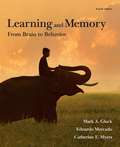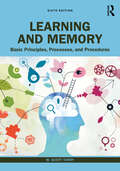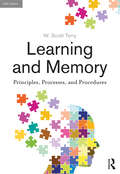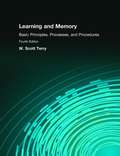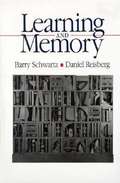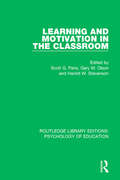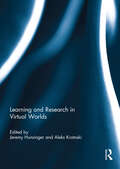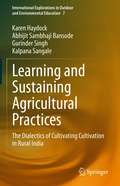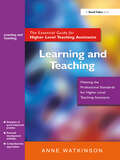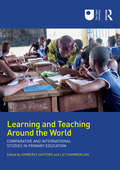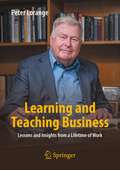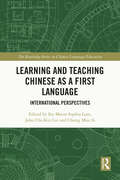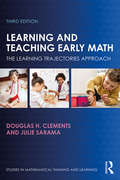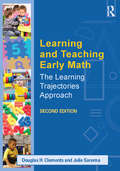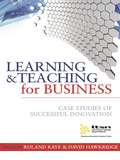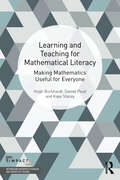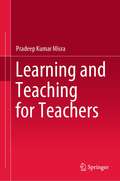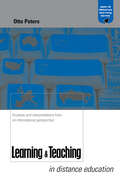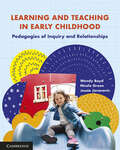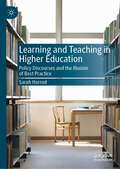- Table View
- List View
Learning and Memory: From Brain to Behavior (Second Edition)
by Mark A. Gluck Eduardo Mercado Catherine E. MyersDevelopments in neuroscience have changed the field of learning and memory significantly in the last ten years. This comprehensive introduction to learning and memory covers behavioural processes, brain systems, and clinical perspectives.
Learning and Memory: From Brain To Behavior
by Eduardo Mercado Mark Gluck Catherine MyersWith real-world examples, fascinating applications, and clear explanations, this breakthrough text helps uninitiated students understand the basic ideas and human impact of groundbreaking learning and memory research. Its unique organization into three sections—Behavioral Processes, Brain Substrates, and Clinical Perspectives—allows students to make connections across chapters while giving instructors the flexibility to assign the material that matches the course. The new edition again offers the book’s signature inclusion of human and non-human studies and full-color design and images. You’ll find even more meaningful real-life examples; new coverage of learning and memory research and brain-imaging; an expanded discussion of the role of genetics in producing individual differences; new material on the role of sleep in memory, and more.
Learning and Memory: Basic Principles, Processes, and Procedures
by W. Scott TerryLearning and Memory provides a balanced review of the core methods and the latest research on animal learning and human memory. Topical coverage ranges from the basic and central processes of learning, including classical and instrumental conditioning and encoding and storage in long-term memory, to topics not traditionally covered, such as spatial learning, motor skills, and implicit memory. The general rules of learning are reviewed along with the exceptions, limitations, and best applications of these rules. Alternative approaches to learning and memory, including cognitive, neuroscientific, functional, and behavioral, are also discussed. Individual differences in age, gender, learning abilities, and social and cultural background are explored throughout the text and presented in a dedicated chapter. The relevance of basic principles is highlighted throughout the text with everyday examples that ignite reader interest in addition to more traditional examples from human and animal laboratory studies. Research examples are drawn from education, neuropsychology, psychiatry, nursing, and ecological (or everyday) memory. Each chapter begins with an outline and concludes with a detailed summary. Applications and extensions are showcased in text boxes as well as in distinct applications sections in every chapter, and review and recapitulation sections are interspersed throughout the chapters.
Learning and Memory: Basic Principles, Processes, and Procedures (Fifth Edition)
by W. Scott Terry<p>This thoroughly updated edition provides a balanced review of the core methods and the latest research on animal learning and human memory. The relevance of basic principles is highlighted throughout via everyday examples to ignite student interest, along with more traditional examples from human and animal laboratory studies. Individual differences in age, gender, learning style, cultural background, or special abilities (such as the math gifted) are highlighted within each chapter to help students see how the principles may be generalized to other subject populations. <p>The basic processes of learning – such as classical and instrumental conditioning and encoding and storage in long-term memory in addition to implicit memory, spatial learning, and remembering in the world outside the laboratory – are reviewed. The general rules of learning are described along with the exceptions, limitations, and best applications of these rules. The relationship between the fields of neuropsychology and learning and memory is stressed throughout. <p>The relevance of this research to other disciplines is reflected in the tone of the writing and is demonstrated through a variety of examples from education, neuropsychology, rehabilitation, psychiatry, nursing and medicine, I/O and consumer psychology, and animal behavior. <p>Each chapter begins with an outline and concludes with a detailed summary. A website for instructors and students accompanies the book. Updated throughout with new research findings and examples the new edition features: <p> <li>A streamlined presentation for today’s busy students. As in the past, the author supports each concept with a research example and real-life application, but the duplicate example or application now appears on the website so instructors can use the additional material to illustrate the concepts in class. <li>Expanded coverage of neuroscience that reflects the current research of the field including aversive conditioning (Ch. 5) and animal working memory (Ch. 8). <li>More examples of research on student learning that use the same variables discussed in the chapter, but applies them in a classroom or student’s study environment. This includes research that applies encoding techniques to student learning, for example: studying: recommendations from experts (Ch. 1); the benefits of testing (Ch. 9); and Joshua Foer’s Moonwalking with Einstein, on his quest to become a memory expert (Ch. 6). <li>More coverage of unconscious learning and knowledge (Ch. 11). <li>Increased coverage of reinforcement and addiction (Ch. 4), causal and language learning (Ch. 6), working memory (WM) and the effects of training on WM, and the comparative evolution of WM in different species (Ch. 8), and genetics and learning (Ch. 12).</li>
Learning and Memory: Basic Principles, Processes, and Procedures (4th Edition)
by W. Scott TerryThis text explores the core principles of learning and memory in a clear, reader-friendly style, covering animal learning and human memory in a balanced fashion.
Learning and Memory 1st Edition
by Barry Schwartz Daniel ReisbergThis book illustrates how various topics in learning and memory are related.
Learning and Motivation in the Classroom (Routledge Library Editions: Psychology of Education)
by Scott G. Paris, Gary M. Olson and Harold W. StevensonThroughout the twentieth century there had been substantial links between scientific psychology and education. Binet, Dewey, Thorndike, and other early pioneers were strongly interested in both realms. Taking advantage of a period of enthusiasm, this title, originally published in 1983, looks at the amalgamation of the recent advances at the time in theory and research in education and psychology, with a particular focus on cognition, motivation and social policy. This volume presents and discusses the implications of this work on learning and motivation for educational policy.
Learning and Research in Virtual Worlds
by Jeremy Hunsinger and Aleks KrotoskiVirtual worlds are places where humans interact, and as such they can be environments for research and learning. However, they are complex and mutable in ways that more controlled and traditional environments are not. Although computer-mediated, virtual worlds are multifaceted social systems like the offline world, and choosing to study virtual world phenomena demands as much consideration for the participants, the environment and the researcher as offline.By exploring virtual worlds as places of research and learning, the international practitioners in this book demonstrate the power of these worlds to replicate and extend our arenas of research and learning. They focus on process and outcomes and consider questions that arise from engaging in teaching and research in these spaces, including new approaches to research ethics, internationalization, localization, and collaboration in virtual worlds.This book was originally published as a special issue of Learning, Media & Technology.
Learning and Sustaining Agricultural Practices: The Dialectics of Cultivating Cultivation in Rural India (International Explorations in Outdoor and Environmental Education #7)
by Karen Haydock Abhijit Sambhaji Bansode Gurinder Singh Kalpana SangaleThis book describes a participatory case study of a small family farm in Maharashtra, India. It is a dialectical study of cultivating cultivation: how paddy cultivation is learnt and taught, and why it is the way it is. The paddy cultivation that the family is doing at first appears to be ‘traditional’. But by observation and working along with the family, the authors have found that they are engaging in a dynamic process in which they are questioning, investigating, and learning by doing. The authors compare this to the process of doing science, and to the sort of learning that occurs in formal education. The book presents evidence that paddy cultivation has always been varying and evolving through chance and necessity, experimentation, and economic contingencies. Through the example of one farm, the book provides a critique of current attempts to sustain agriculture, and an understanding of the ongoing agricultural crisis.
Learning And Teaching
by William DharmarajThis book is about of every stage in our life is being moulded to bring modifications in our knowledge and behaviour. Thus changes in our behaviour are brought by the experiences that we gained through the interaction with the environment and its people.
Learning and Teaching: The Essential Guide for Higher Level Teaching Assistants
by Anne WatkinsonLearning and Teaching concentrates on the practical teaching skills that an HLTA needs to be able to use in the classroom. It offers guidance and support on fulfilling the standards and succeeding in the classroom role. This book includes: real-life case studies that put the theory behind the standards into a whole-school context practical activities that convey how the standards can be used in the classroom guidance on the school-based aspects of the training and assessment advice on the difference between the learning and teaching standards for newly qualified teachers and HLTAs. This book is complemented by a companion volume, Professional Values and Practice which underpins the philosophy, values and practice of support at this level.
Learning and Teaching Around the World: Comparative and International Studies in Primary Education
by Kimberly Safford Liz ChamberlainLearning and Teaching Around the World is a wide-ranging introduction to diverse experiences, practices and developments in global primary education. It explores different contexts for children’s learning, and methods and purposes of primary education, in settings across Africa, Asia, Europe, the Americas and Australasia, and addresses wider issues such as the rise of refugee learners and large multi-grade classes. With an explicit focus on comparative and international studies and improving the knowledge, understanding and practice of effective pedagogies for children’s learning, this book reflects on key issues such as: Standards for learner-centred education Patterns of inclusion and exclusion Defining ‘teacher professionalism’ The impact of global education agendas Language policy for schooling and assessment Learning and Teaching Around the World is an essential text for those wishing to develop a critical understanding of the experiences of primary teachers and children around the world. Aimed at both undergraduate and postgraduate education studies students, the scope of this book will support all students in developing knowledge of primary education and of the diverse needs of learners in an era of global movement of children and families.
Learning and Teaching at M-Level: A Guide for Student Teachers
by Ms Hazel Bryan Simon Hoult Chris CarpenterYour teacher training or professional development course will now probably include Masters level assessment and credits as teaching 'becomes an M-level profession' and a greater emphasis is placed on helping teachers develop deeper understandings about aspects of learning and teaching through a higher level of critical reflection. This book will guide you through the various different aspects of doing M-level work at either primary or secondary stage, and help you to develop a deeper professional understanding. Your ability to research and understand learning environments will form a key part of making you an inquisitive and better teacher, and engagement with research underpins the book. Chapters include primary and secondary vignettes and examples to help link theory into practice, as well as reflective questions, activities and suggestions for further reading. This book is relevant to all trainee and qualified teachers working across the age ranges of 7-19.
Learning and Teaching Business: Lessons and Insights from a Lifetime of Work
by Peter LorangeBusinesses constantly look for ways to achieve better performance, and business schools play an important role through their curricula by teaching such methods and helping budding and experienced managers find innovative paths. The author of this book, Prof. Peter Lorange, a well-accomplished expert at business and academic leadership, draws on a set of reflections from his vast experience in both fields to offer core messages which help in improving business education. The author believes that experience-based reflections tend to be both more interesting and more useful than mere chronological, biographical ones, or conceptual reviews of management dimensions without links to practice. The book helps academics, business school management, and even advanced students understand how to bring a practical focus to learning and teaching business via a holistic curriculum. The book also features a special focus on how to integrate family business perspectives to the curriculum.
Learning and Teaching Chinese as a First Language: International Perspectives (The Routledge Series on Chinese Language Education)
by Lee, John Chi-Kin Chung Mou Si Lam, Sin Manw SophiaIn this book, the authors embark on a critical investigation of the complex field of Chinese language education, with a particular focus on exploring new trends and teaching and learning. They delve into the intricacies of language, education and its effectiveness in teaching Chinese as a first language.The book has three objectives: establishing a field of study in Chinese language learning and teaching, providing critical discussion and progressive insights on language education, and offering relevant pedagogical perspectives of learning and teaching Chinese as L1 and L2. The chapters investigate learning and teaching of Chinese in different aspects, including four skills, culture, literature, technology-assisted learning, and learners’ identity. By focusing on the teaching practices of Chinese at different levels, it sheds light on teaching Chinese as a first language. Theoretically, it broadens the linguistic and geographical reach of previous works on language education that mainly examine English as a lingua franca or children’s first language acquisition. Drawing upon theories in language learning, the book demonstrates the applicability of language theories in the first language and Chinese as a non-alphabetic language and examines the impact and effectiveness of some theories in Chinese learning and teaching.Academic researchers, teacher educators, teachers and students interested in Chinese language and education will find this a highly relevant text for its focus on curriculum, pedagogy and assessment of teaching Chinese as a first language.
Learning and Teaching Community-Based Research
by Catherine Etmanski Budd L. Hall Teresa DawsonCommunity-Based Research, or CBR, is a mix of innovative, participatory approaches that put the community at the heart of the research process. Learning and Teaching Community-Based Research shows that CBR can also operate as an innovative pedagogical practice, engaging community members, research experts, and students.This collection is an unmatched source of information on the theory and practice of using CBR in a variety of university- and community-based educational settings. Developed at and around the University of Victoria, and with numerous examples of Indigenous-led and Indigenous-focused approaches to CBR, Learning and Teaching Community Based-Research will be of interest to those involved in community outreach, experiential learning, and research in non-university settings, as well as all those interested in the study of teaching and learning.
Learning and Teaching Early Math: The Learning Trajectories Approach (Studies in Mathematical Thinking and Learning Series)
by Douglas H. Clements Julie SaramaThe third edition of this significant and groundbreaking book summarizes current research into how young children learn mathematics and how best to develop foundational knowledge to realize more effective teaching. Using straightforward, practical language, early math experts Douglas Clements and Julie Sarama show how learning trajectories help teachers understand children’s level of mathematical understanding and lead to better teaching. By focusing on the inherent delight and curiosity behind young children’s mathematical reasoning, learning trajectories ultimately make teaching more joyous: helping teachers understand the varying levels of knowledge exhibited by individual students, it allows them to better meet the learning needs of all children. This thoroughly revised and contemporary third edition of Learning and Teaching Early Math remains the definitive, research-based resource to help teachers understand the learning trajectories of early mathematics and become confident, credible professionals. The new edition draws on numerous new research studies, offers expanded international examples, and includes updated illustrations throughout. This new edition is closely linked with Learning and Teaching with Learning Trajectories–[LT]²–an open-access, web-based tool for early childhood educators to learn about how children think and learn about mathematics. Head to LearningTrajectories.org for ongoing updates, interactive games, and practical tools that support classroom learning.
Learning and Teaching Early Math: The Learning Trajectories Approach (Studies in Mathematical Thinking and Learning Series)
by Douglas H. Clements Julie SaramaIn this important book for pre- and in-service teachers, early math experts Douglas Clements and Julie Sarama show how "learning trajectories" help diagnose a child's level of mathematical understanding and provide guidance for teaching. By focusing on the inherent delight and curiosity behind young children's mathematical reasoning, learning trajectories ultimately make teaching more joyous. They help teachers understand the varying levels of knowledge exhibited by individual students, which in turn allows them to better meet the learning needs of all children. Using straightforward, no-nonsense language, this book summarizes the current research about how children learn mathematics, and how to build on what children already know to realize more effective teaching. This second edition of Learning and Teaching Early Math remains the definitive, research-based resource to help teachers understand the learning trajectories of early mathematics and become quintessential professionals. Updates to the new edition include: * Explicit connections between Learning Trajectories and the new Common Core State Standards. * New coverage of patterns and patterning. * A companion website featuring student support materials such as a glossary of technical terms and pedagogical activities. * Incorporation of hundreds of recent research studies.
Learning and Teaching for Business: Case Studies of Successful Innovation
by Roland Kaye David HawkridgeThis collection of best practice examples of business teaching should inspire and inform those involved in the improvement of teaching in higher education. Assembled by the Learning and Teaching Support Network the examples are drawn from institutions throughout the UK including: The Open University, Sheffield Hallam, City University, St Andrews, Brighton, De Montfort, Liverpool John Moores, Glasgow, Leeds Met and Plymouth. Individual case studies focus on everything from the use of action learning, resource based learning, using technology and peer assessment to the development of a knowledge management system.
Learning and Teaching for Mathematical Literacy: Making Mathematics Useful for Everyone (IMPACT: Interweaving Mathematics Pedagogy and Content for Teaching)
by Hugh Burkhardt Daniel Pead Kaye StaceyTypically, most people don’t realize when and how they can use the mathematics they were taught in high school – yet many of the mathematical ideas and skills can be a powerful tool for understanding how the world works. Learning and Teaching for Mathematical Literacy addresses this situation, offering practical strategies for developing a broader vision of mathematical literacy in the classroom and recognising the importance of maintaining these skills into adult life. Linked to the material explored throughout this book, classroom activities and lesson materials are freely available for use via the QR codes included in each chapter. Filled with case studies and classroom activities, chapters tackle several topics: Describing a framework for a broader vision of mathematical literacy – what is it, and why is it important? Teaching mathematical literacy in the classroom Applying mathematical literacy to ‘real life’ scenarios: My dad is buying a new dishwasher. Should he buy the extended warranty on offer? My phone works fine but I've been offered an upgrade. How should I decide whether to take it? The role of technology in teaching mathematical literacy Designing mathematical measures for real-word quantities Firmly grounded by practical applications for the classroom and beyond, this is an essential handbook for any teacher, teaching assistant, or mathematics subject lead who wishes to develop their students’ mathematical literacy skills. This is also an ideal resource for those delivering or enrolled in teacher preparation courses.
Learning and Teaching for Mathematical Literacy: Making Mathematics Useful for Everyone (IMPACT: Interweaving Mathematics Pedagogy and Content for Teaching)
by Hugh Burkhardt Daniel Pead Kaye StaceyTypically, most people don’t realize when and how they can use the mathematics they were taught in high school – yet many of the mathematical ideas and skills can be a powerful tool for understanding how the world works. Learning and Teaching for Mathematical Literacy addresses this situation, offering practical strategies for developing a broader vision of mathematical literacy in the classroom and recognising the importance of maintaining these skills into adult life. Linked to the material explored throughout this book, classroom activities and lesson materials are freely available for use via the QR codes included in each chapter.Filled with case studies and classroom activities, chapters tackle several topics: Describing a framework for a broader vision of mathematical literacy – what is it, and why is it important? Teaching mathematical literacy in the classroom Applying mathematical literacy to ‘real life’ scenarios: My dad is buying a new dishwasher. Should he buy the extended warranty on offer? My phone works fine but I've been offered an upgrade. How should I decide whether to take it? The role of technology in teaching mathematical literacy Designing mathematical measures for real-word quantities Firmly grounded by practical applications for the classroom and beyond, this is an essential handbook for any teacher, teaching assistant, or mathematics subject lead who wishes to develop their students’ mathematical literacy skills. This is also an ideal resource for those delivering or enrolled in teacher preparation courses.
Learning and Teaching for Teachers
by Pradeep Kumar MisraThis book provides a comprehensive and balanced description of learning and teaching by connecting it to secondary and higher education teachers’ experiences and practices in day-to-day life. Woven around research conducted by educationists, psychologists, and practitioners around the globe, this book presents key concepts and addresses significant discussions and concerns with regard to learning and teaching in the present age. Seeking to help teachers understand learners’ learning needs, preferences, and styles and manage their teaching plans, priorities, and practices accordingly, it details the main ideas and emerging practices related to learning and teaching in a very easy to ‘read, understand, and practice’ way. The first five chapters approach learning from different perspectives, while the next six explain in detail how to practice teaching to maximize learning outcomes. Combining the traditional textbook-style approach of content description with a self-learning approach based on various real-world situations and activities related to both learning and teaching, this textbook is particularly valuable for teachers in school education, higher education, and teacher education. This book is also an essential resource for fulfilling teachers’ continuing professional development requirements. Although intended for teachers worldwide, the book especially helps teachers in South Asian countries to improve learning outcomes in their classrooms and, subsequently, the quality of their education systems.
Learning and Teaching in Distance Education: Analyses and Interpretations from an International Perspective (Open and Flexible Learning Series)
by Otto PetersThis unique and comprehensive overview of open and distance education is written by one of the best known names in the field. It integrates historical, contemporary and future aspects of distance education. Packed with international case studies, it goes beyond looking at the methods and technology of distance education, giving Otto Peters' renowned visions on the sociological and social impacts of distance education.Now published in paperback for the first time, this new edition includes a new section on virtual universities. A major contribution to thinking on open and distance education, this new edition will reach an even wider audience.
Learning and Teaching in Early Childhood: Pedagogies of Inquiry and Relationships
by Wendy Boyd Nicole Green Jessie JovanovicLearning and Teaching in Early Childhood: Pedagogies of Inquiry and Relationships is an introduction for early childhood educators beginning their studies. Reflecting the fact that there is no single correct approach to the challenges of teaching, this book explores teaching through two lenses: teaching as inquiry and teaching as relating. The first part of the book focuses on inquiry, covering early childhood learning environments, learning theories, play pedagogies, approaches to teaching and learning, documentation and assessment, and the policy, curriculum and regulatory requirements in Australia. The second part explores relationships in early childhood contexts and covers topics such as fostering meaningful and respectful relationships with children, and working with families, staff and the wider community. Written by well-respected academics in the field, Learning and Teaching in Early Childhood is a vital resource for those entering the early childhood education and care profession.
Learning and Teaching in Higher Education: Policy Discourses and the Illusion of Best Practice
by Sarah HorrodThis book explores the discourses in learning and teaching policy in UK higher education, traces how these ideas are recontextualised at institutional level and reveals the differences between policy discourses and lecturers’ and students’ experiences. The author argues that policy ideas around learning and teaching are not simply value-free ‘best practice’ but reflect the socio-political context of higher education. The study uses an innovative conceptual framework of critical discourse studies (CDS) and Bernstein’s sociology of pedagogy to provide critical lenses to uncover the underlying messages of policy. The book will interest a wide academic audience including anyone involved in higher education globally.

